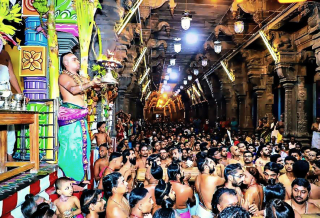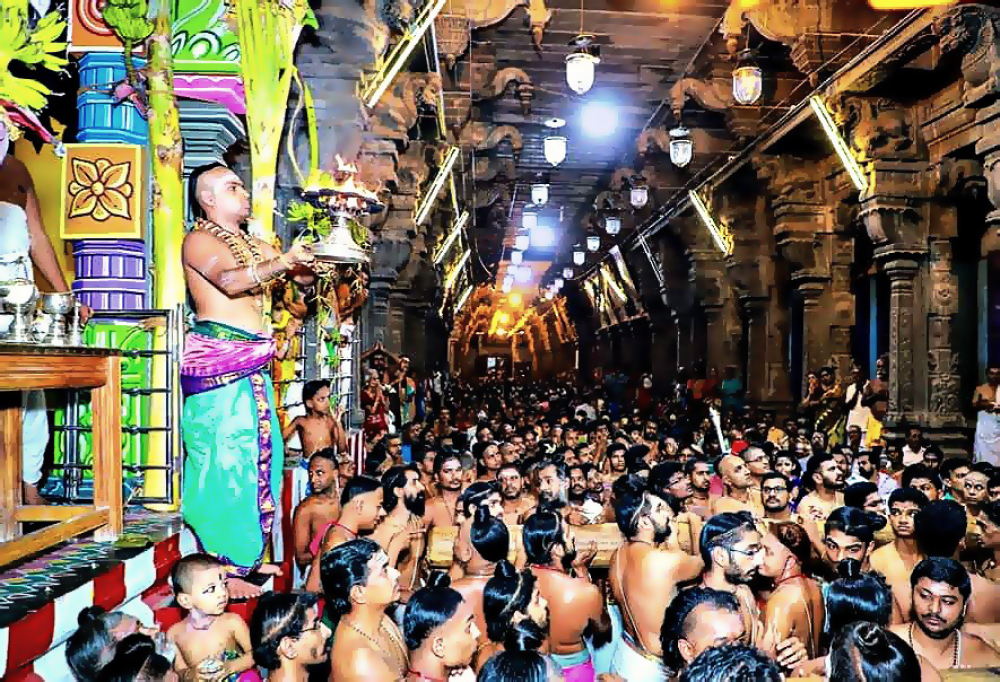Category: Journalism Photography
Post Type:
Photography
Mixed Media: None | Journalism Photography
Pays
one point
and 2 member cents.





© Copyright 2024. seshadri_sreenivasan All rights reserved.
seshadri_sreenivasan has granted FanStory.com, its affiliates and its syndicates non-exclusive rights to display this work.
Posted: July 1, 2019
      |
Journalism Photography
Hindu Worship In Temples
by seshadri_sreenivasan
Interested in this? Contact The Artist
Journilistic Contest Entry
Photograph taken during a Festival in a Hindu Temple in Chennai. Cellphone shot with OnePlus3T android camera. Image very slightly adjusted for light. No cropping or resizing.
Hindu worship is primarily an individual act rather than a communal one, as it involves making personal offerings to the deity. Worshipers repeat the names of their favourite gods and goddesses, and repeat Mantras/Chants..
Festivals play are very large part in the day to day life of Hindus and they portray and rich cultural traditions of the country. In Hindu tradition, a festival is observed with prayers and different rituals such as fasting, decorating the deities, cooking special dishes, community fairs, etc. The festivals usually commemorate special events from Hindu mythology but this often coincides with seasonal changes or agricultural cycles such as the sowing or harvest season.
Festivals play are very large part in the day to day life of Hindus and they portray and rich cultural traditions of the country. In Hindu tradition, a festival is observed with prayers and different rituals such as fasting, decorating the deities, cooking special dishes, community fairs, etc. The festivals usually commemorate special events from Hindu mythology but this often coincides with seasonal changes or agricultural cycles such as the sowing or harvest season.
The rich and vibrant festivals of India are a testimony to our diverse tradition and culture. Festivals in India revolve around Lord?s birthdays, traditional myths, seasonal changes, relationships, and much more. Festivals are celebrated irrespective of religion or caste in the country, bringing people closer and creating a strong bond of humanity.
The most widely accepted explanation for taking off shirts while visiting temples or performing puja/worship at home seems to be humility and equality.
Clothes are a symbol of affluence. The better off you are, the better quality your clothes are. This is evident to not just you, but also others who stand beside you. Such thoughts are a distraction from the purpose you go with to the temple. This is reason why men wear dhotis of the same color as well- modesty and uniformity.
Not having clothes on your upper part of the body also serves two other purposes. One is that the person going so is going "openly", so to speak- with no inhibitions and approaching the place of worship with only the body they were born with.
It also enables others to know the extent of your religiousness and knowledge because branding on the upper body, especially arms, shoulders and upper back is common practice(especially among men who've crossed middle age, symbolic of the next stage of life) in Hinduism.
by seshadri_sreenivasan Interested in this? Contact The Artist
Hindu worship is primarily an individual act rather than a communal one, as it involves making personal offerings to the deity. Worshipers repeat the names of their favourite gods and goddesses, and repeat Mantras/Chants..
Festivals play are very large part in the day to day life of Hindus and they portray and rich cultural traditions of the country. In Hindu tradition, a festival is observed with prayers and different rituals such as fasting, decorating the deities, cooking special dishes, community fairs, etc. The festivals usually commemorate special events from Hindu mythology but this often coincides with seasonal changes or agricultural cycles such as the sowing or harvest season.
Festivals play are very large part in the day to day life of Hindus and they portray and rich cultural traditions of the country. In Hindu tradition, a festival is observed with prayers and different rituals such as fasting, decorating the deities, cooking special dishes, community fairs, etc. The festivals usually commemorate special events from Hindu mythology but this often coincides with seasonal changes or agricultural cycles such as the sowing or harvest season.
The rich and vibrant festivals of India are a testimony to our diverse tradition and culture. Festivals in India revolve around Lord?s birthdays, traditional myths, seasonal changes, relationships, and much more. Festivals are celebrated irrespective of religion or caste in the country, bringing people closer and creating a strong bond of humanity.
The most widely accepted explanation for taking off shirts while visiting temples or performing puja/worship at home seems to be humility and equality.
Clothes are a symbol of affluence. The better off you are, the better quality your clothes are. This is evident to not just you, but also others who stand beside you. Such thoughts are a distraction from the purpose you go with to the temple. This is reason why men wear dhotis of the same color as well- modesty and uniformity.
Not having clothes on your upper part of the body also serves two other purposes. One is that the person going so is going "openly", so to speak- with no inhibitions and approaching the place of worship with only the body they were born with.
It also enables others to know the extent of your religiousness and knowledge because branding on the upper body, especially arms, shoulders and upper back is common practice(especially among men who've crossed middle age, symbolic of the next stage of life) in Hinduism.
Mixed Media: None | Journalism Photography


Hindu Worship In Temples
by seshadri_sreenivasan

You need to login or register to write reviews. It's quick! We only ask four questions to new members.
© Copyright 2024. seshadri_sreenivasan All rights reserved.
seshadri_sreenivasan has granted FanStory.com, its affiliates and its syndicates non-exclusive rights to display this work.

